Undersowing maize: Trials, tips and all you need to know
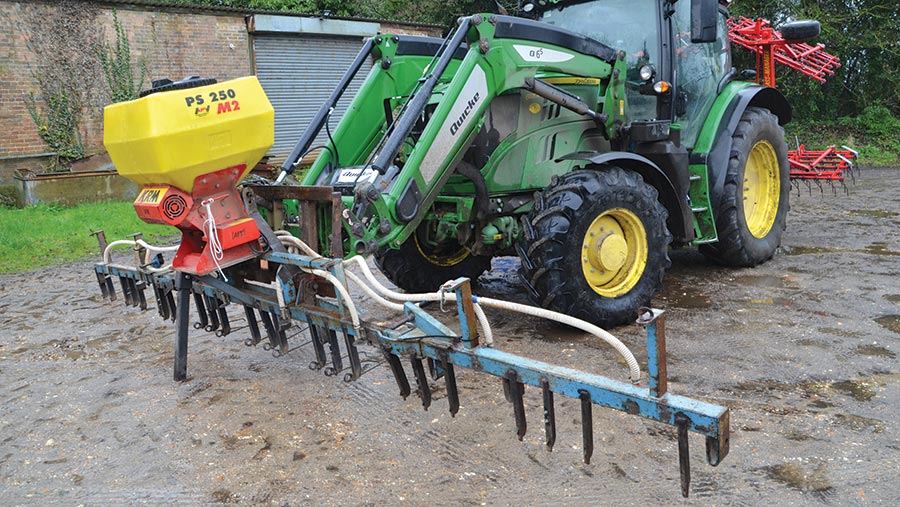
Undersowing maize crops with grass to keep valuable nitrates in the soil can help growers reduce losses caused by late-season harvesting and compacted ground, but getting it established correctly is crucial to prevent leaching after rainfall.
Dorset dairy farmer Brian Chandler and head tractor driver Tom Mears have been employing this technique for the past 20 years.
During that time, the pair have trialled a range of different methods and machines to get grass established under the maize crop’s canopy.
See also: Driver’s view: Vaderstad Tempo maize drill
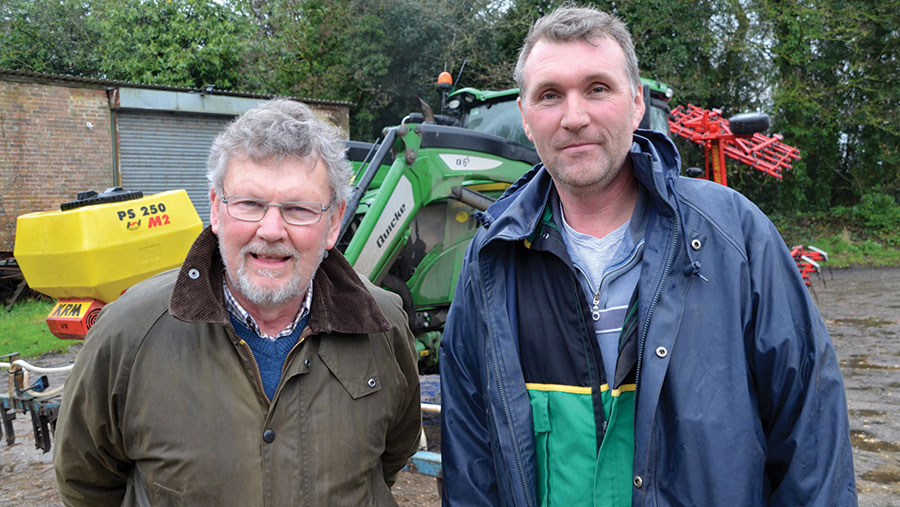
Brian Chandler and Tom Mears
The sandy soil makeup at Hurst Farm has required this kind of soil management to protect it against even small amounts of rainfall that would otherwise lead to nitrate leaching in the sensitive Poole Harbour catchment area the farm sits within.
Wessex Water has now set up a number of trails at Hurst Farm to assess the merits of different establishment tools and techniques – one of a number of trials taking place around the country (see “Other trials in the UK”).
Farm facts
- Farmed area – 465ha
- Cropping – Maize 134ha, wholecrop triticale 24ha, stubble turnips 16ha – remainder in permanent pasture and grass leys
- Livestock – 550-600 Holstein-Fresian milkers (averaging 7,500-litres/year) plus 800-1,000 followers
- Machinery – Two John Deere 6135Rs, Massey Ferguson 5445 plus another eight Masseys (135s to 188s); 19cu m Shelbourne Reynolds feeder wagon; 3,000-litre Knight trailed sprayer
- Staff – Brian Chandler and Tom Mears, plus another seven full-timers and another five part-time
First attempts
“The bare soil between the rows of maize both before and after harvest presents a big run-off risk on our gravelly, sandy loams. With any amount of rain, it will just wash straight out the gateway,” explains Mr Chandler.
“Years ago, I realised we needed to have a catch-crop to avoid that run-off, but it was a bit of a trial-and-error process to work out how best to do it.”
Initially, grass seed was spun on with a broadcaster immediately behind the forager, but establishing it so late meant that the seedlings were unable to develop a decent root structure to hold back the soil prior to the high-risk winter period.
Having a green cover established in the growing maize crop was considered essential, so a different approach was adopted.
“Rather than putting fertiliser down the spout at drilling, we’ve always tended to top dress the crop with urea once it’s up and away.
“That presented an opportunity to sow some grass.
“We started mixing seed with the fertiliser and spinning it on at the same time.
“It certainly worked and there was a carpet of fine, green leaves once the crop was cut, but it was incredibly wasteful as half the seed would end up trapped in the maize plants.”
The next step was to develop a machine capable of accurately distributing grass under the crop canopy.
For this purpose, the folding toolbar from an old set of Parmiter zig-zag harrows was dragged out of the nettles and, with a bit of grinding and welding, Tom Mears fashioned a frame to accommodate an APV air-seeder.
Its eight fan outlets were then evenly spaced along the folding beam and Euro 8 loader brackets grafted on in place of the original headstock.
“We wanted to front-mount the machine to maximise visibility but didn’t want the expense of a front-linkage – it fitted perfectly on the loader,” explains Mr Mears.
“That arrangement means we can easily alter the height dependent on crop growth stage.
“The only modification required was to tilt the fan outlets down a touch to limit the throw of seed between the rows.”
Establishment issues
This setup immediately proved itself in the first year, with seed rates reduced accordingly to allow for the reduced losses.
However, germination rates weren’t deemed to be as good as they could have been due to a lack of seed-to-soil contact.
Mr Mears went back to the workshop once again and decided the best course of action was to fit grass-harrow-type tines on the toolbar – three to run between each row of maize plants.
While this arrangement improved things, it wasn’t aggressive enough and establishment wasn’t particularly uniform – grass generally came up more reliably where it had been rolled in by the tractor wheels.
So last year saw a further modification to the system with the addition of a 6m Einbock grass harrow carried on the rear linkage.
Tines on the implement’s frame were removed to avoid damage to the growing maize crop, leaving eight rows to scratch up a tilth and cover the seed behind the tractor.
“The Einbock worked a treat in loosening the soil surface and covering the seed but it didn’t provide any consolidation, which is critical on our gravelly soil types.
“Seeing how well the seed used to come up when it was run in by the tractor, I’d like to try to add some tyres to run between each row to get decent seed-to-soil contact.
“Whether the Einbock frame is up to it, I’m not sure. I think it’ll take some fairly major modification to do that.”
Trials
Alongside these on-farm developments, Hurst Farm has also played host to some more formal trials with Wessex Water for the past three seasons.
Keen to limit nitrogen leaching in the Poole Harbour catchment area, the utility company has been working with farmers for a while to help develop techniques to hold back nutrients in the field.
Wanting to draw on Mr Chandler and Mr Mears’ experiences in 2017, the firm set up a field-scale experiment to measure the effectiveness of various techniques of establishing catch crops in maize at the farm.
With porous pots installed across the trial field to measure nitrate leaching, strips of crop were treated in several different ways, mostly during the five-to-seven-leaf stage but also following the previous harvest:
- Post harvest – stubble disced, seed broadcast and rolled in
- undersowing – grass sown using Hurst Farm’s home-built, loader mounted seeder toolbar with inter-row tines
- Grass harrow – grass sown with a Stocks broadcaster on a rear-mounted Browns harrow with rows of tines removed to avoid damage to the maize
- Slurry seeder – grass seed mixed with slurry through the induction hopper on the filling pipe and applied with 24m dribble-bar.
Results
The results of the trial were as expected. Undersowing maize with an Italian ryegrass reduced nitrate leaching by an average of 42kg/ha of nitrogen compared with leaving the stubble bare over winter.
This compares favourably with grass sown after harvest, which reduced leaching by 20kg/ha of nitrogen.
The Hurst Farm home-built band-sowing rig produced the greatest establishment rates and, consequently, was the best in holding back nutrient loss into groundwater.
Grass splattered on with slurry came in a close second.
Establishment with the harrows and broadcaster saw similar issues to the farm’s original broadcasting approach, with seed loss into the standing maize crop.
The 2018 and 2019 growing seasons saw a further technique added to the mix.
Developed in conjunction with a number of contractors and catchment protection organisations, the Weaving Inter Row drill employs three disc coulters with individual rubber press wheels running between each crop row placing seed directly into the soil surface.
In a dry year, this was felt to offer big advantages in guaranteeing reliable establishment thanks to the consolidation and seed-to-soil contact it provides.
“You could definitely see the grass had come up quicker and thicker where the drill had been, but we didn’t feel it was significant enough to justify the expense, particularly as it would only have a two-week working window each year,” says Mr Mears.
Grass under maize plus-points
- Catch crop saves any nitrogen that would otherwise be lost through bare ground
- Limits top-soil run-off
- Root structure makes soil much more workable
- Overwinter sheep-keep opportunity
- Potential early bite for cows or first-cut silage
- Better travelling conditions for slurry applications and harvest
“We had another bigger concern. It is a heavily built bit of kit, which means you need a fairly hefty tractor to run it on.
“With skinny wheels on recently ploughed ground, we were concerned about the amount of compaction that could cause.”
The Browns harrow and broadcaster suffered the same issues of seed loss into the standing maize as early Hurst Farm attempts and would probably work better if the seeder was changed for one capable of placing the seed in bands under the crop canopy.
Mixing grass seed with slurry and applying it via dribble bar worked well with cow muck, but pig slurry didn’t produce such good results, possibly being too rich in certain nutrients.
In addition, the heavy machinery required was a cause for concern.
Post-harvest grass establishment has been tried both with the Einbock and with the front-mounted seeder toolbar and a set of ring rolls, depending on conditions.
Although this works, the young seedlings weren’t established enough by the winter to develop a decent root system capable of holding back run-off effectively.
For now, Hurst Farm’s home-built seeder and harrow approach at the four-to-six-leaf stage remains the practice of choice.
If an element of consolidation can be added to aid seed-to-soil contact then so much the better.
Lessons learned
- Herbicides – everything hinges around weed control chemicals. Experience with 30 years of continuous maize at Hurst Farm suggests it’s best to use a standard pre-emergence product and follow that two to three weeks later with a selective herbicide. However, it’s important to choose the right one as residual activity can continue right into the autumn and has been found to completely knock out the undersown grass.
- Timing – closely linked to the herbicide regime, Mr Chandler’s advice is to leave undersowing as late as you dare, ideally at the four-to-six-leaf stage. This affords the pre-em products plenty of time to work their magic.
- Crop damage – don’t be overly concerned by damage done to the maize by the seeding rig’s wheelings, especially crossing the headlands. Experience at Hurst Farm suggests it’s surprising how well run-down, dead-looking plants will revive.
- Seed rates – Mr Chandler’s view is that the best bet is to use low seed rates – 15-20kg/ha. Then, if the grass doesn’t establish, you can still afford to have another go in the autumn.
- Grass varieties – Mr Chandler has tried all sorts of cover crops over the years, from vetches and clovers through to ryegrasses and barley. The go-to seed choice is now a Westerwold, as it’s quick to establish but happy to sit dormant and then rocket away after harvest.
- Establishment – don’t be disheartened if the grass doesn’t seem to come to anything. Often there are tiny green wisps that sit dormant until the maize crop is off, and within two to three weeks, there’s generally a lush, green carpet. In dry years, the seed can sit on the soil surface doing nothing until there’s rain, and even then it tends to get up and away once the forager has been through.
- Slurry – if you want to apply a dressing of slurry to the growing crop, use tractors and tankers on wide, low-pressure tyres at the two-leaf stage running at 45deg to the crop rows. The young seedlings aren’t badly damaged by big flotation rubber and will quickly bounce back.
Other trials around the UK
There is lots of work going on across the UK and Europe looking at the best ways of limiting nutrient leaching and holding back soil loss from run-off. Here’s a round-up of some of the trials:
United Utilities, Cheshire
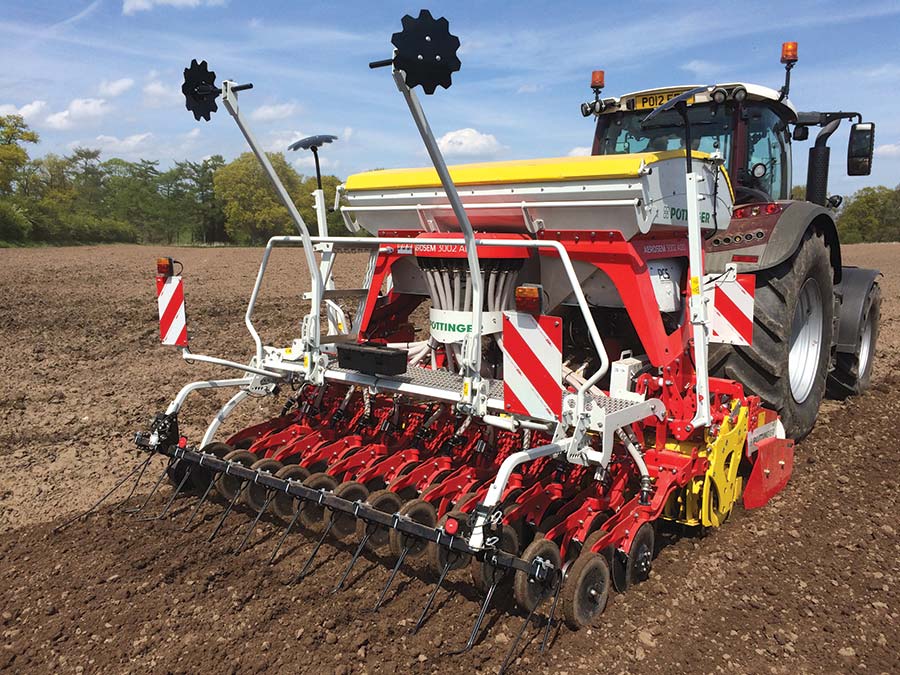
In 2018, United Utilities set up a trial in Cheshire to evaluate different methods and timings for establishing grass cover crops in maize.
Accepting that different approaches are needed on different farms, the company wanted to demonstrate the possibilities of using alternative types of machinery at varying times, so that growers could see what would fit on their own individual farms.
Within this, a number of different grass species were tried to assess their potential impact on maize growth, dry matter yield and, ultimately, their ability to capture nitrogen and limit leaching.
The three main techniques employed were:
- Grass undersown at maize drilling with a Pottinger Aerosem PCS (Precision Combi Seeder) power-harrow combination drill capable of planting maize and grass simultaneously
- Grass broadcast with a fertiliser spreader as the maize reached the two-to-eight-leaf stage
- Grass sown into the standing crop at the four-to-eight-leaf stage with a pneumatic inter-row disc-coulter drill.
Plus points for the Pottinger approach were that it was a reliable one-pass method of establishing grass early.
Seed placement was precise between the rows so that interference with the growing maize crop was minimised.
The downsides were that there could be competition issues with early established grass and it could potentially restrict post-drilling herbicide choices.
Broadcasting was the lowest-cost option with the fastest work rates, but establishment was uneven and unreliable.
Seed placement was patchy and had the potential to cause in-row competition with the maize seedlings and, again, limits herbicide options.
The purpose-built, inter-row drill was felt to be the most precise and provided the greatest opportunity for flexibility in tailoring seed rates and varieties to crop growth stage.
Wye and Usk Foundation, Welsh Borders
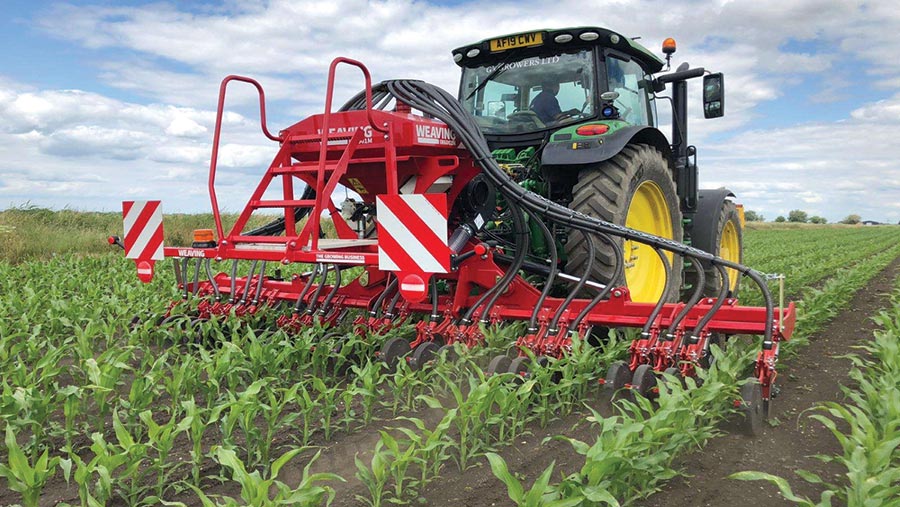
After a couple of informal field trials broadcasting Italian ryegrass into maize in 2014 and 2015, in 2016, the Wye and Usk Foundation in the Welsh Borders built its own inter-row drill to improve establishment.
Since then, it has been offering an undersowing service to maize growers in its catchment areas.
This approach expanded in 2018, when the organisation purchased a second inter-row drill based on the original design but now manufactured by Weaving Machinery.
The undersowing service is part of a partnership with Field Options (a local seed company).
Up to this point, the two drills have been undersowing about 90ha each, limited slightly by field locations, when they were drilled and the weather.
The organisation is just about to take delivery of two further drills for the 2020 season to improve the efficiency of logistics when moving them around the catchment.
This should help to ensure coverage of a greater area in what is sometimes a fairly short window of opportunity due to erratic weather.
Key conclusions from growers that have taken up the practice are:
- Prolonged dry weather after sowing can reduce the success of germination. This has mainly been an issue in soils with depleted organic matter levels, where water holding capacity is reduced and, therefore, seedlings are less resilient in dry conditions.
- No impact seen on maize yields.
- Where poor soil structure impacts on maize height/vigour, grass growth can be higher as more light reaches it below the maize canopy.
- Undersown grass can provide significant quantities of grazing for the following spring.
Severn Trent, Nottinghamshire
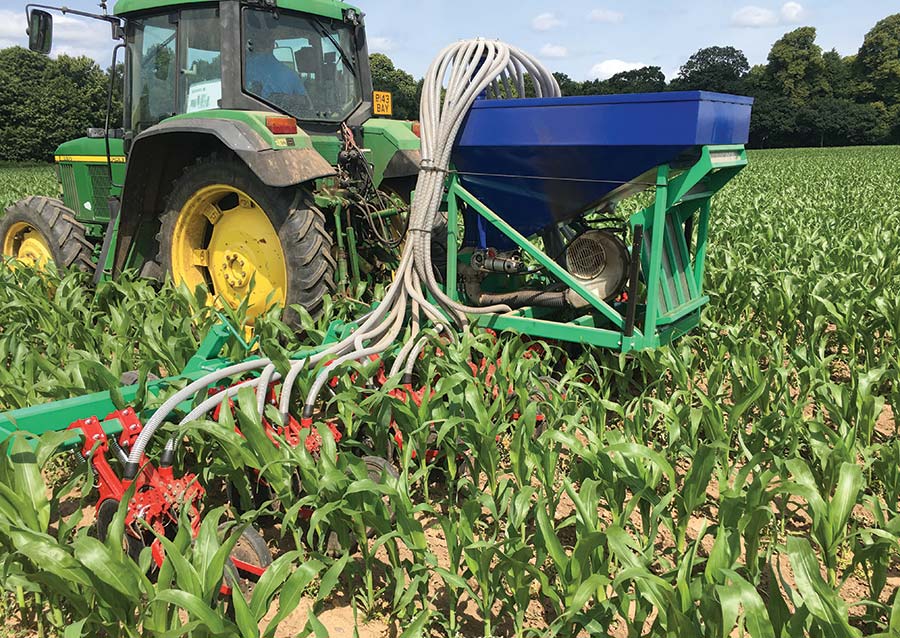
The Sherwood sandstone aquifer that runs through Nottinghamshire yields about half of the county’s public water supply and is under increasing pressure from rising nitrate levels.
Trials set up in the area by Severn Trent Water have looked into all sorts of factors impacting the growing maize crop and the effects of an undersown catch crop.
The aim of this project was to look at way of reducing the impact of nitrate leaching from maize stubble and cut the risk of soil erosion.
Various seed mixes, rates and timings of undersowing were trialled.
The impact of different row widths and the timing of digestate applications and nitrate inhibitors were also assessed.
It is hoped that ongoing trials will produce results that will guide farmers as to ways to improve their practice without sacrificing yield.
Maize was undersown using a custom-built drill and an Opico grass harrow for comparison.
Seed-to-soil contact is important for germination and, on the dry, sandy soils in Nottinghamshire, it is important to get the grass away quickly.
Broadcasting is too risky at the time of year maize needs to be undersown, and the grass harrow can dry out what little moisture is on the surface and not all the seeds will get buried.
It can have positive and negative effects on weed control.
The custom-built drill, like a lot of the other undersowing rigs, uses Weaving disc coulters with press wheels.
This worked particularly well and gave good establishment at lower seed rates.
It uses a recycled Accord fan, metering unit and distribution head.
The seed rate can be quickly calibrated and adjusted using an RDS Artemis Lite control system.
The drill can be set up for 75cm spacing with three rows of discs and 50cm spacing with two rows of discs.
It folds to 2.8m for easy road transport and the hopper can hold 300kg-plus of grass seed to reduce filling stops.
Undersowing in 2019 was done at 10kg/ha and 15kg/ha with either Agrovista’s Enviromax mix or Westerwolds.
The Enviromax seemed to cope with the later undersowing and has persisted better through the wet autumn and winter.
The highest-yielding plot was undersown with Enviromax at 10kg/ha (69t/ha wet at 32% dry matter) and the lowest-yielding plot was also undersown clover and chicory (45t/ha wet at 32% dry matter).
It appears that the topography of the field, soil type and spray programme had more of an effect on yield than the undersowing.
Because the plots with pendimethlin treatment had seven weeks between spraying and undersowing, the herbicide didn’t appear to have any negative impact on grass establishment.
This year, the trial will look at undersowing earlier, the impact of varying seed rates versus drilling dates and chemical control, as well as harvest date.
Reaseheath College, Cheshire
Trials conducted at Reaseheath College have compared the effects of undersowing grass into maize at the four-to-six-leaf stage, establishing the two crops at the same time using a Pottinger AeroSem PCS drill capable of sowing both maize and grass simultaneously.
Over two seasons, the maize was found to yield better with grass sown at the same time compared to those plots where it was undersown.
This was attributed to a number of factors.
Being able to actively drill the grass at a 15cm distance from the maize rows limited competition and enabled the “cash crop” to get away with maximum vigour.
The choice of grass varieties was found to be critical – fescues had the best combination of vigour and persistence.
However, herbicide regime choice is the one area that needs careful attention.
Agrovista, Devon
One of the biggest issues of undersowing maize with a companion cover crop is how to tackle weed control.
Pre-emergence herbicides will obviously effect grass establishment.
To try to establish the best method, Agrovista set up a trial in 2017 in Devon using the Pottinger Aerosem with grass sown between the rows of maize.
It was found that the pre-emergence chemicals held back grass growth but not to the point where seedlings were killed off. That enabled the maize to get ahead.
It also showed that undersowing without a pre-em can cause yield reductions if conditions are good for grass growth, enabling it to out-compete the maize.
Where pre-emergence products are not used it’s critical to reduce grass seed rates.
We know this is probably not an exhaustive list of the work going on around the country to look at undersowing maize with catch crops.
This issue is likely to develop, so if you’ve got experience that you would like to share, please get in touch by emailing oliver.mark@proagrica.com

